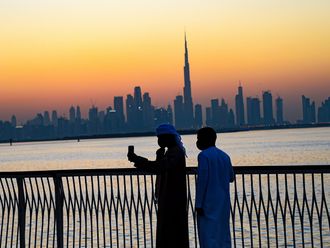
Who hasn't passed a van full of horses on Shaikh Zayed Road and thought of taking a picture? Or gone to Musandam for a day trip and tried to take photographs of dolphins? Who hasn't seen a strangely worded menu in a creek-side café (computer juice, anyone?) and felt like taking a photograph to share with friends?
Digital cameras mean that photography has become an easy hobby.
What has not changed is the joy a good photo can bring. Once you have mastered the technique, the only thing that makes you stand out is your world view. And while a good photograph can be put to several uses such as making calendars, wallpapers or art, there is none more rewarding and fulfilling than a photo blog.
Finding fame
Over the years, there have been many successful photo blogs. Perhaps the most famous is Scott Schuman's The Sartorialist. A former fashion salesperson, Schuman began carrying a digital camera around on the streets of New York City, taking pictures of smartly dressed people who caught his eye and then posting them on his blog with a couple of comments, seeing them as a designer might. His astute eye garnered him commissions from serious fashion publications, including style.com, and he has since published an anthology of his images in book form.
It is possible to create a photo blog with anything. Frequent travellers with shutter-happy fingers are known to do that — not the least because their audience can click through a slide show at leisure. Blogs detailing funny road signs, situations that are eye-catching, or even wild life sightings are all in cyberspace today.
Clarity of purpose
But it's important to know your purpose and that of the photos. If they are about more than one subject, the unifying factor needs to be more than the photographer.
The most fundamental question you must answer is who your target audience is — even if all you are doing is photographing your newborn as she yawns, there must be clarity of purpose. Do you want her to be discovered by advertising folks? Do you want to sell advertising on your blog? Or is it just to share family pictures with friends and relatives?
The purpose will determine how you organise the pictures on your blog.
Start by choosing a web hosting company that will allow you to set up a blog. Posting them on Facebook isn't quite the same thing.
At the start you may need to tell friends and family about your blog — the only way to get traffic on your site. Having pictures published on the internet and having people actually visit your blog are two entirely different things.
Then, start adding text. Learn about the HTML elements necessary for search engines to find and index your pictures.
Increasing traffic
The first rule is to always caption your pics intelligently. Remember, this is also how your picture will show up in search.
If the pictures are just for family consumption, you can organise them by date or by events.
However, once you identify a purpose, for example, strange dance moves that you see at events, you need to further organise them by footwork, hand movements, or similar folders.
If you have a travel blog, for example, it would make sense to mark the images belonging to that place at the time.
A photo blog will structure your text by titles, subtitles, categories and tags, which make you searchable.
Some attention is more or less guaranteed if you follow these simple steps when hosting a photo blog. Once you get used to it, there are numerous other things to do with your photo blog. You can count the number of visitors, you can link to other blogs, have conversation with strangers like you and have fun in the process.
**************
Top sites: Check out the leading photography blogs
1. Digital Photography School
2. Strobist
3. DIYPhotography.net — DIY Photography and Studio Lighting
4. Chase Jarvis Blog
5. Joe McNallys Blog
Source: Invesp.com
Some UAE photo blogs
• the dubai chronicles: Jeff's journey through Dubai and the UAE through photography and everyday life stories
• Abu Dhabi Daily Photograph: Not really daily and not only Abu Dhabi
• Escapism: A Dubai-based online photography gallery and photo blog that displays the work of freelance photographer, Jason Kotecha
• Weekend Photos: from Naushad
• Hello Analog: a daily exposure of images shot in 35 and 120mm film
• Stop or I'll shoot!: showcasing the work of a photo newbie
— S.S.
*************
Picture perfect for posterity
After you have painstakingly captured those scenes, shared them with friends and basked in their praise, what happens to all your pictures? It is just as fulfilling to save and store your pictures as it is to shoot them. Here are some basic guidelines.
Storing digital pictures sensibly: When pictures are downloaded from a digital camera, they sport tags such as DSC165 or IMG166. It is practical and easy to change these to something more meaningful like ‘Nikki's wedding, Paris'. Numerous websites offer online photo storing. While many services are free, the ones that charge annual subscriptions offer more storage space and security.
Retrieving pictures easily: Pictures saved in a PC must be backed up on a CD or external hard drive in case of a computer crash. Both online services and software include features to sort and classify pictures by albums. Descriptive titles can shorten search time. Tagging by venue, date, or occasion will make identification, retrieval and cataloguing effortless.
Preserving old and new prints: Sunlight, humidity, mould, chemicals and insects can cause extensive damage to photographs. Experts say the best way to preserve photographs is to arrange them on archival paper and mount them using photo corners. The pages must then be inserted into clear pockets and stored in a portfolio or box made of archiving material, and saved in a cool, dry place for longevity.
Restoring old prints: As long as the pictures don't have scratches, tears, stains or wrinkles, professional-looking restorations can be attempted at home. All it takes is a PC, scanner, photo printer, and image editing software such as Adobe Photoshop or Microsoft Picture Editor. Standard restoration features, in scanners and/or software, include corrections in colour, contrast, brightness and cropping. Restored version can be printed and saved digitally. Digitisation also allows endless experimenting until the outcome is perfect.
Here are some helpful websites and software to keep your negatives and photos in good condition.
• Digital Restoration ME (www.digitalrestorationme) are professionals at restoring negatives and pictures, and offer a free sample for large quantities.
• Epson Photo RX-630 All-in-One can save negatives, slides and photos, and allows easy printing, scanning and copying of pictures.
• Fujifilm's Photodisc CD-R is a CD especially made for long-term storage of digital photos.
• Kodak Gallery offers online photo sharing, photo gifts and superior prints from digital photos at www.kodakgallery.com
— Iona Stanley/Gulf News Report













